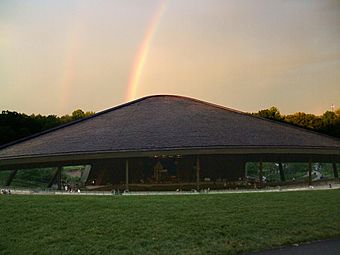Blossom Music Center facts for kids
 |
|
 |
|
| Address | 1145 W Steels Corners Rd. |
|---|---|
| Location | Cuyahoga Falls, Ohio |
| Coordinates | 41°11′29″N 81°33′38″W / 41.191298°N 81.560678°W |
| Owner | Musical Arts Association (non-classical booking by Live Nation) |
| Type | amphitheater |
| Capacity | 23,000 |
| Opened | 1968 |
Blossom Music Center, often called Blossom, is a large outdoor concert place in Cuyahoga Falls, Ohio, USA. It's the summer home for The Cleveland Orchestra and where their yearly Blossom Festival happens. The Musical Arts Association, which runs the Orchestra, owns Blossom Music Center.
Contents
Blossom Music Center: A Brief History
Blossom Music Center is named after the Blossom families, Dudley S. Blossom Sr. and Jr. Dudley Sr. was once the president of the Musical Arts Association. His family kept supporting the group after his son, Dudley Jr., passed away. The president of the Board, Frank E. Joseph, felt the Blossom family deserved this honor.
Building the Amphitheater
The main stage area, called the pavilion, is made of slate and steel. It can seat 6,051 people. Behind the pavilion is a big grassy area where another 15,000 people can sit on blankets or chairs. This makes the total capacity about 23,000! Blossom is also known for its natural bowl shape, the sloped roof of the pavilion, and the beautiful wooded area around it.
For many years, musicians in The Cleveland Orchestra wanted to play music all year. In the early 1950s, they sometimes played at Public Auditorium in Cleveland. They even played at Cleveland Stadium before Indians baseball games. In the mid-1960s, the music director, George Szell, wanted to find summer jobs for his musicians.
Finding a Home for Music
In 1965, the Musical Arts Association started looking for a place to build a summer home for the Orchestra. Szell had a clear idea: he wanted a place that was "exceptional, absolutely first rate, terribly attractive."
In July 1966, the Musical Arts Association bought 571 acres of land. This land was in what was then Northampton Township. It was about 10 miles north of Akron and 30 miles south of Cleveland. Later, they bought more land, bringing the total to 800 acres.
Construction and Opening Day
By 1967, the Musical Arts Association started a fundraising campaign. They wanted to raise money to build Blossom's pavilion. The first team included an acoustician named J. Christopher Jaffe and an architectural firm from Cleveland. They designed and built the amphitheater. As construction went on, Szell preferred a German recording engineer, Heinrich Heilholz, who took over from Jaffe. The fundraising campaign reached its goal of $6.6 million. Construction officially began on July 2, 1967.
The first concert at the Blossom Festival was on July 19, 1968. George Szell conducted Beethoven’s Ninth Symphony. It was even shown live on TV! The next year, the Orchestra held its first Fourth of July concert at Blossom. Meredith Willson, who wrote The Music Man, led the performance.
Updates and Popular Events
In 2003, Blossom had a big update that cost $17 million. This improved the sound system, stage, guest services, parking, and landscaping. In 2011, the Musical Arts Association sold 580 acres of undeveloped land to Cuyahoga Valley National Park. This helped the Orchestra financially and protected Blossom's natural surroundings.
Blossom is also a very popular place for other types of music. Many folk, rock, and country artists have played there. The largest crowd recorded at Blossom was for a Blood, Sweat and Tears concert in 1969, with 24,364 people. An unofficial guess for a Pink Floyd concert in 1973 was 32,000 people!
Many music festivals have been held at Blossom. These include Lollapalooza, Mayhem Festival, Ozzfest, and Vans Warped Tour. The Michael Stanley Band, very popular in Northeast Ohio, set an attendance record in 1982. They had four sold-out shows with 74,404 people attending. Rock artist James Taylor was the first to play two nights in a row in 1979, with over 42,000 people attending both shows.
See also
- List of contemporary amphitheatres
- Live Nation

